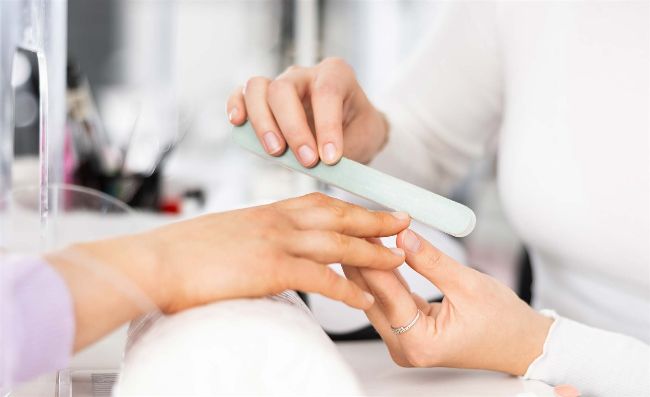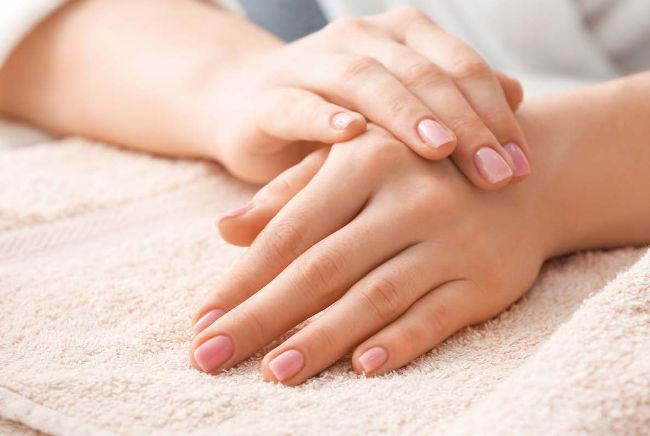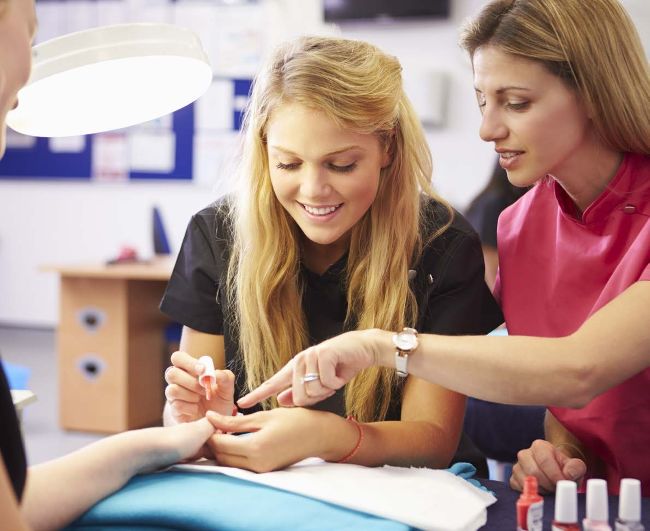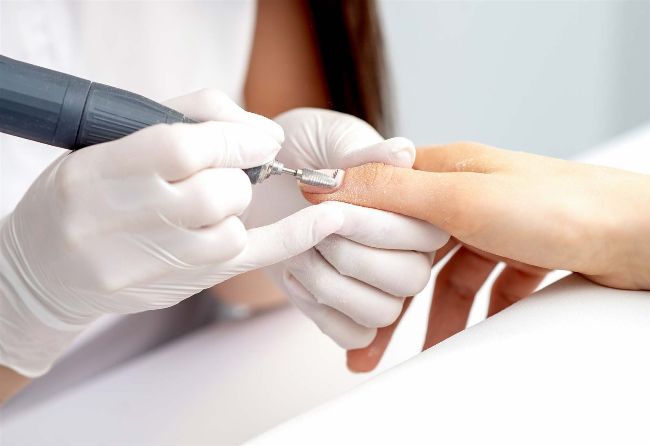NAIL TECHS: how to prevent contact allergies
The British Association of Dermatology (BAD) has recently raised fresh concerns about the safe use of gel systems following increasing reports of allergies.

BearFotos_Shutterstock
The BAD first issued a warning in 2018, after a study titled Epidemic of (Meth)acrylate Allergy in the UK Requires Routine Patch Testing found that 2.4% of people tested had an allergy to at least one type of (meth)acrylate chemical – an ingredient found in acrylic, gel and gel-polish.
Although the DIY at-home gel kits popularised by consumers during the pandemic are being blamed for many of the cases of allergies, they can still occur in professional settings – with the BAD saying that nail technicians are most at risk of developing an allergy.
It’s important that professional nail techs know how to protect both their clients and themselves, so we asked nail experts to share their best practice for preventing contact allergies.
Is gel polish safe?
“Gel polish is safe when used by a professional nail technician who is competent and knowledgeable in all areas of nail technology,” says Katie Barnes, award-winning nail tech and owner of Katie Barnes Tool Range and Training Academy.
“This knowledge needs to include health and safety, and the nail tech needs to follow Health and Safety Executive (HSE) guidelines including Control of Substances Hazardous to Health (COSHH), wear PPE and follow manufacturing instructions.”
Barnes adds, “As with any chemical ingredient, including our household cleaning products, when this is not used correctly or the above is not followed, issues will arise.”
In addition to following best practice, the gel product being used also has an impact on safety.
Suzanne Clayton, brand development manager and interim head of education at Louella Belle, and founder of Nail Tech Awareness, explains, “Gel polish is safe when it is applied and removed correctly using products that have correct ingredient percentages.”
What are the symptoms of allergies to gel polish?
Firstly, it’s important to identify whether symptoms are caused by an irritation or an allergy to a substance.
Contact dermatitis occurs when a product causes an irritation, with skin usually becoming red, blistered, dry and cracked.
“This usually improves if the substance causing the problem is identified and avoided, preventing it from developing into an allergy,” comments Barnes. “An irritation reaction usually occurs within a few hours or days of exposure to an irritant or allergen.
Allergic contact dermatitis is an allergy that builds up over time from overexposure to an allergen over days or weeks through it coming into contact with the skin – in the case of gel polish allergies, this allergen is usually one or more ingredients in nail products.
“The first time you come into contact with an allergen, your body becomes sensitised to it, but doesn’t react to it,” Barnes explains.
“Only when you’re exposed to the substance again does your immune system react and cause the skin to show signs of irritation.
“Itching, redness, swelling, burning, peeling or blistering are all ways that your body is telling you that something is wrong.”
These symptoms might not always appear on the nails and hands, with Clayton adding that puffy eyes and an irritable nose or breathing problems can also be indicators.
“Symptoms on the nail plate can look like the white free edge has moved down half or more of the nail plate (oncholysis), there may be blood splinters (splinter haemorrhaging) or bruising and discolouration on the nail plate,” says Clayton.
“Underneath the nail, we might see a thickness growing between the nail bed and the nail plate (hyperkeratosis). This can appear from the first appointment, or months or years later.
“Nails can take months to heal properly, and nasal problems can take much longer.”
Barnes agrees: “The symptom duration can vary greatly between individuals, much dependent on whether an irritation or allergy is present.
“It could range from 24 hours, to several weeks. Repetitive skin contact with an allergen will continue to worsen if the skin contact does not cease.”
How long does a gel polish allergy last?
“An allergy will never go away because the immune system will never forget that specific allergen,” says Barnes.
As well as preventing future application of gel polish containing these allergenic ingredients, allergies can also affect other aspects of life.
Clayton adds, “It can affect medical treatment because the same adhesive ingredients [like HEMA] are used in dental treatments, hip and knee replacements, diabetic patches, artificial cataracts and more, so you may have trouble when needing medical treatment.
“You have to have a dermatology test to find out what ingredient you have reacted to. You may or may not be able to have gels again.”
Which ingredients in gel polish can cause allergies?
There are several ingredients often found in gel polish that are known to cause allergies, especially when they are found in high concentrations within products.
Common allergen culprits include hydroxyethyl methacrylate (HEMA), which is used as an adhesive, and isobornyl acrylate (IBOA) – you can see whether gel products contain these by checking their SDS.
Barnes says that the reason why HEMA might be reporting more allergies than other ingredients is because the molecular size of HEMA is very small, so it can be absorbed into the skin and nail plate more easily than others – although HEMA has been used safely in nail products for years without issue when health and safety guidelines are followed correctly.

Konstantin_Ivlev_Shutterstock
When it comes to what to look out for with HEMA concentrations in polishes, Clayton says, “The recommended guideline is 35% but most brands have way less than that.
“There are gels on the market that are HEMA-free but we have to be careful about which ingredient has been used in its place for adhesion.”
Barnes adds, “Having an adhesive property in the product, such as HEMA, is important to prevent surface breakdown. When alternative ingredients are used, using a coarser grit file can be necessary to ensure adhesion, in turn having its own issues and causing potential damage to the nail plate.”
Barnes says that awareness of ingredients isn’t the only factor in preventing allergies from occurring – nail techs also need to be vigilant about the way they’re working.
“You can change to a product no longer containing HEMA or other allergens if desired, but if you don’t change the working technique, an allergy will just occur to another ingredient and it will become a vicious circle,” she explains.
“Once an allergy develops, the immune system goes onto heightened alert, so it becomes much easier and faster to develop allergies to other ingredients in future – so switching to HEMA-free brands and rebranding is not the answer.”
This further highlights the danger of consumers attempting to do their own gel manicures at home without proper training and knowledge of safe working practices.
Why are more cases of gel polish allergies being reported now?
There are several reasons why there has been an uptick in the number of allergy cases reported in recent years.
“While an increase of home users has contributed to the rise in allergies, they cannot be solely blamed because many nail technicians and their clients are experiencing irritation and allergies,” explains Barnes.
Barnes believes that the rise of low-quality short training courses has also played a role in increased allergic reactions.
“Many of these courses or techs looking for a quick fix don’t cover important aspects such as health and safely, SDS, product chemistry, PPE and the necessary topics required to protect nail technicians and their clients,” she says.
Clayton agrees that lack of education and training is an issue: “We have had untrained people using products they do not know how to apply and cure, and they have been mixing products and brands.

Monkey Business Images_Shutterstock
“We have had professionals not using a matching lamp and applying products too thick or building a product they have not been trained to use.”
The rise in popularity in builder gels may also be partly responsible.
“Since ‘builder gels’ in a bottle became popular, we’ve seen an increase in reactions,” says Clayton.
“There are lots of techs and beauty therapists who were only trained in gel polish suddenly using builder gels despite having never built an apex or extended a nail before.
“The products were being applied too thick to cure and a matching lamp was not being used. Some products had so many acrylates in them it would have been impossible to cure them anyway.
“Gel that has not been fully cured all the way through causes a huge problem. It will leach out onto the nail plate while the client is wearing the polish for however many weeks, which will sensitise the nail and eventually cause a reaction.”
Brands also need to be vigilant about their production processes. Clayton explains, “We have had an influx of brands come onto the market that have trusted what manufacturers have told them and haven’t had the products independently tested.
“Years ago, you needed tens of thousands of pounds to start a brand, whereas now you only need a few hundred. This has meant that just about anyone can and does start a brand with little knowledge on what they are passing on to consumers or professionals.”
What can nail techs do to prevent clients having allergic reactions to gel polish?
Since allergies are caused by products coming into contact with the skin, it’s important to understand how this contact is happening.
Improperly cured gel is a common cause of contact allergies. A full cure can be ensured by using lamps from the same company as the gel polish you’re using, and by making sure the bulbs in the lamp are clean and functioning properly.
Prep work can also lead to skin contact: “Skin contact can occur from over aggressively filing the natural nail with a coarse-grit nail file such as a 150 or 100 grit,” Barnes explains.
“A 240 or 180 grit file is all that is required to file the natural nail and remove the shine. If you use a coarser grit, you will remove layers of the nail plate, making the nail thinner and more susceptible to absorbing nail ingredients and causing an allergy.”
Of course, accidents happen, and skin contact might occur from dropped product.
“It is essential to remove this product immediately with IPA or gel cleanser, and get the clients to wash their hands,” Barnes says.
“Do not dry wipe or use fingers or a nail tool to tidy this up because uncured product will still be present on the skin, albeit not visible, and will contribute towards an allergy or irritation.”
Other factors Barnes recommends taking into consideration in order to keep clients safe are:
• Avoiding overly large brushes and the one-bead method
• Always using the correct mix ratio
• Following manufacturers’ instructions
• Keeping your working area clean and dust free
What should nail techs do if they think their client has developed an allergy to gel polish?
“If an allergy is suspected, cease treatment immediately and do not apply any further nail products until the client has had an allergen test with a dermatologist,” says Barnes.
“During an allergen patch test, tiny amounts of known allergens are applied to the skin. The substances are attached to your back, or sometimes your arms, using a special kind of non-allergenic tape.
“After two days, the patches are removed, and your skin is assessed to check if there has been any reaction.”

Michelle Aleksa_Shutterstock
“It is essential to ensure that your gloves provide chemical resistance against the ingredients you use in your nail services. You also need to change your gloves regularly according to the chemical resistance time for your brand. You can obtain the thickness and glove chemical resistance time from your manufacturer.”
If you have developed an allergy to nail products, it’s important to get to the bottom of the cause. It might not be as simple as flooding cuticles or dropping products onto bare hands.
“If symptoms are occurring on your face, then it is likely that you are touching your face unknowingly,” Barnes explains. “This then identifies that the transfer of allergen is coming from your hands and likely contamination of product transferring to your face.
“Consider things such as wearing a visor or mask to help break the habit of touching your face in order to protect the area in question.
“Even if you are wearing gloves, if you get uncured gel on them accidentally, think of where this could transfer to, for example, gel bottles and pots, switches, UV or LED lamps and nail tools. By transferring this product to high-contact points that are likely to be repetitively touched, you’re more likely to transfer uncured product to the skin.”
Sometimes it might not be direct contact of the product causing issues. Dust particles from gel products can also cause allergies.
Barnes recommends investing in a dust extraction unit, rather than a dust collector, to help to remove dust particles from the air and prevent them coming into contact with the skin.
“What you wear is also important if you suspect dust particles as the cause of the allergy,” she adds. “You must ensure all areas of your skin and your client’s skin is covered by wearing long sleeves, visors and masks.
“I recommend wearing long-sleeved and high-necked tops that you can tuck into your gloves, avoiding skin contact points for allergens and dust.
“It is also important to address what material your uniform is and how absorbent it is; if some product comes into contact with the material, it will soak through.
“Seek a uniform that isn’t very absorbent, and add wipeable and removable layers such as an apron so that these can be removed should contact occur. Always have a spare uniform at work if product gets on your clothes.”
Images courtesy of Katie Barnes, depicting a nail tech customer of hers (who has granted permission for these images to be used) and showing the progress of her allergy to over 10 nail ingredients, as diagnosed by a dermatologist. The nail tech’s condition improved and she was able to wear nails again after changing her working techniques and wearing the correct gloves.
Article first appeared in the UK edition of PROFESSIONAL beauty magazine on 3 May 2023.